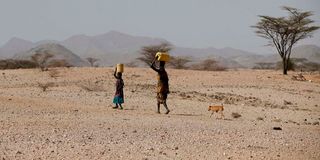Climate crisis: Is this a repeat of history?

Pastoralist communities in Turkana and Garissa are losing livelihoods as rains vanish and temperatures rise.
What you need to know:
- Pastoralist communities in Turkana and Garissa are losing livelihoods as rains vanish and temperatures rise.
- As the climate warmed, earth’s temperature rising by as much as 10 degrees Celsius, the oceans absorbed much of this heat.
Some 252 million years ago, the earth nearly died. A chain of colossal volcanic eruptions in what is now Siberia released staggering amounts of carbon dioxide into the atmosphere. Temperatures soared, oceans turned acidic and lost their oxygen, forests withered, and coral reefs vanished.
In the end, over 90 per cent of marine life and 70 per cent of land animals were wiped out in the single worst extinction event in earth’s history. Scientists call it the Permian –Triassic extinction, or simply “The Great Dying.” Today, we are walking a disturbingly similar path, but this time, the volcano is us.
Scientists have identified five other major mass extinctions in earth’s history. The earliest occurred around 443 million years ago, during a global ice age that wiped out much of marine life. The Devonian extinction (~372 million years ago) disrupted ecosystems in the seas, while the Triassic extinction (~201 million years ago) paved the way for the rise of dinosaurs.
Sixth mass extinction
The most famous is the Cretaceous extinction (~66 million years ago), caused by an asteroid impact that ended the age of dinosaurs. But the worst by far was the Permian extinction, a near total collapse of life driven by runaway climate change from volcanic CO₂ and methane. Today, scientists warn that we may be entering a sixth mass extinction, however, this time caused by human activity.
Across Kenya and around the world, climate disruption is no longer abstract. Flash floods are paralysing our urban centres. Droughts are deepening hunger in arid counties. Our agricultural lifelines, from maize to tea are under threat.
Pastoralist communities in Turkana and Garissa are losing livelihoods as rains vanish and temperatures rise. Unlike the slow-motion disaster of the Permian, today's crisis is human-driven. Our factories, farms, vehicles, and energy systems are now releasing over 37 billion tonnes of carbon dioxide every year at a rate far faster than even the ancient Siberian volcanoes.
Earth’s temperature rising
During the Permian extinction, the Siberian Traps volcanoes erupted continuously for nearly a million years, injecting vast volumes of CO₂ into the atmosphere. According to a high-precision geochronological study published in Science by Seth Burgess and colleagues, these eruptions coincided exactly with the extinction horizon. The Siberian Traps are estimated to have released between 10,000 and 100,000 gigatons of CO₂ over that period, as noted by Black and colleagues in Geology.
As the climate warmed, earth’s temperature rising by as much as 10 degrees Celsius, the oceans absorbed much of this heat. This destabilised frozen methane reserves on the seafloor, releasing large amounts of methane, a potent greenhouse gas, which scientists estimate contributed up to 20 per cent of the total warming.
The results were catastrophic. Ocean chemistry changed rapidly, becoming both acidic and oxygen-deprived. Food chains collapsed. Species that had thrived for hundreds of millions of years vanished. Even fossil sites in South Africa confirm the scale of this environmental catastrophe.
Dr Clabe Wekesa is a Postdoctoral Researcher at the Max Planck Institute for Chemical Ecology and adjunct Lecturer at Masinde Muliro University of Science and Technology

